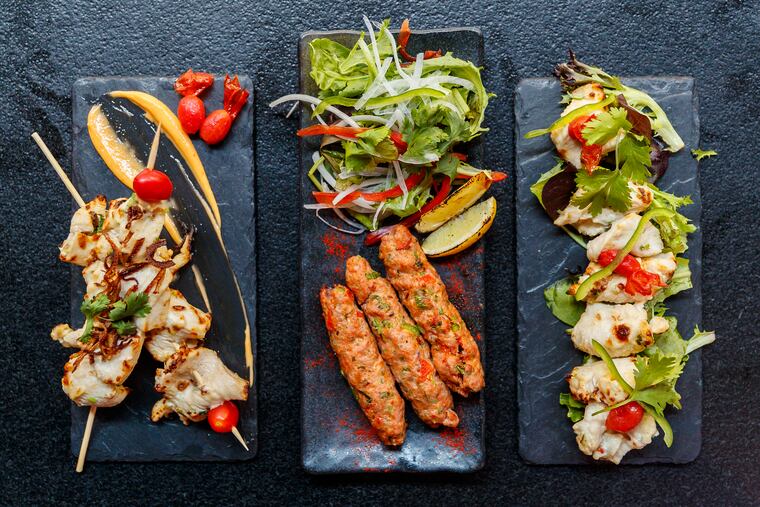Building a better kebab: Cook quickly, double the flavor, and separate the meat from the vegetables
Done right, a skewer can add up to more than the sum of its impaled parts.

If there is one cooking tradition that Americans have really made a hash of, it’s the backyard kebab. Does anyone actually look forward to eating inane ruffles of red onions, undercooked-but-still-charred wedges of green pepper, and barely seasoned, rubbery hunks of meat? The kebab’s convenience almost never justifies its presence on the grill — not when you could have just had a burger.
“I’ve noticed that vegetables often tend to be burnt or limp when they are cooked on the skewers with meat,” says Vipul Bhasin of Veda Modern Indian restaurant in Center City. This is rarely a problem in Indian cuisine, in which skewered meats tend to stand alone.
Yet the culinary convention of proteins plus vegetables on a stick makes for a quick, healthy meal. Done right, it can also add up to more than the sum of its impaled parts.
One way to ensure that the vegetables don’t lose out is to dispense with the idea of cooking them on the skewers altogether. At Suraya — and, indeed, many other restaurants preparing grilled food to scale — vegetables are grilled separately from the meat. Chef Nick Kennedy recommends putting soft veggies, like cherry tomatoes, in wire baskets, or sturdier ones, like string beans, directly on the coals for more efficient cooking and more surface-sear action.
“If you do them separately, it gives you more control,” Kennedy says.
He explains Suraya’s skewer strategy: “Generally with a kebab, we are trying to get as close to the coals as possible so you don’t give the fat and juices time or space to vaporize and turn into black smoke or ash … you want it to cook fast to keep that flavor and juice inside. So we start close, rotate it quickly, and then raise the food up off the heat. The same thing goes for the vegetables.”
Forget those speared, cloudy onion triangles of indeterminate rawness — Kennedy will grill an onion whole and unpeeled for 10 minutes (or until it’s about three-quarters of the way cooked through), then cut and skewer it for maximum caramelization. The same goes for an eggplant. It can sit right on the coals until it shrinks up.
There’s no rule that says vegetables even have to be grilled. As with satay or yakitori, or even the ground-meat kofte kebabs of the Middle East, skewered meat can stand on its own. Serve a salad or a relish instead of mediocre pepper planks and your guests will thank you.
Or go strictly vegetarian and thread the vegetables with paneer or halloumi cheese cubes dressed in a spicy herb oil. Food 52’s meatless kebabs nicely solve the shish dilemma with an easy mashup of Indian and Middle Eastern cuisines.
Kebabs’ other big bugaboos — lack of flavor and unwelcoming textures — can be addressed with better technique. In Indian cuisine, that might be a two-step marination process. Bhasin’s traditional murg malai chicken kebab recipe starts with a tenderizing bath of lemon juice, salt, ginger and garlic. The second soak — in cream, egg, cheddar cheese, hot pepper, and spices — ensures boneless skinless chicken breasts don’t taste anything-less.
Kennedy does something similar with his fish kebabs, made with either striped bass, swordfish, or halibut. He brines the fish first, then marinates it in spiced, garlicky yogurt flecked with citrus zest. Serve the chunks of grilled fish with reserved (but not used) marinade and grilled vegetables, so that the juices of the cooked fish and tomatoes run into the creamy yogurt, making a sauce best sopped up by bread or rice.
At Society Hill’s Isot, green peppers and tomatoes are intrinsic to the flavor of chef/owner Fatih Kekec’s chicken kebabs.
“Everything has to be the same size or it won’t cook evenly,” he says.
Kekec learned how to make kebabs from his grandfather, who hailed from the city of Gaziantep, known for shish kebab excellence. There’s much more that goes into skewered meats than most people know, he says. True shish kebab, as in the authentic Turkish article, is not something a home cook can whip up at a moment’s notice.
“You have to pick the right cut of meat,” he says. “You have to have the right marination. It usually takes one day. The right spices. Good olive oil. We use special grills and we turn the kebabs in special ways. And here, if you go to a kebab restaurant, they will serve it with white rice, and that changes everything. It’s supposed to be served with bulgur.”
“A lot of the kebabs I eat in America are not made the way we would do it in Turkey,” Kekec says. “If you do it the right way, it tastes delicious.”